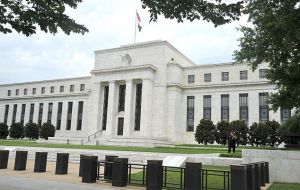MercoPress. South Atlantic News Agency
US filings for unemployment benefits fall to its lowest since 1973
 The bullish jobs picture, together with a firm housing market brings the Federal Reserve a step closer to hike interest rates this year.
The bullish jobs picture, together with a firm housing market brings the Federal Reserve a step closer to hike interest rates this year.  Initial claims for unemployment benefits fell 26,000 to a seasonally adjusted 255,000 for the week ended July 18, the lowest level since November 1973
Initial claims for unemployment benefits fell 26,000 to a seasonally adjusted 255,000 for the week ended July 18, the lowest level since November 1973  US job growth has exceeded 200,000 in 14 of the last 16 months and at 5.3%, the unemployment rate is close to the 5.0% to 5.2% Fed range
US job growth has exceeded 200,000 in 14 of the last 16 months and at 5.3%, the unemployment rate is close to the 5.0% to 5.2% Fed range The number of US citizens filing new applications for unemployment benefits last week dropped to its lowest level in more than 41 and a half years (1973), suggesting the labor market maintained a sturdy pace of job growth in July.
Other data on Thursday also offered an upbeat assessment of the economy. A gauge of future economic activity increased solidly in June and another measure suggested growth picked up slightly last month.
The bullish jobs picture, together with a firm housing market brings the Federal Reserve a step closer to hike interest rates this year.
Initial claims for state unemployment benefits fell 26,000 to a seasonally adjusted 255,000 for the week ended July 18, the lowest level since November 1973, the Labor Department said.
However, last week's drop likely exaggerates the strength of the labor market as claims are volatile during boreal summer when automakers usually shut assembly plants for annual retooling.
Some firms keep production lines running, which can throw off a model the government uses to smooth the data for seasonal variations.
A US Labor Department analyst, however, said there were no special factors influencing the data. Still, the decline unwound the increase in claims in June.
Fed officials meet next week, but they are not expected to tighten monetary policy before September. The Fed has kept its short-term lending rate near zero since December 2008.
Payrolls increased 223,000 in June after rising 254,000 in May. Job growth has exceeded 200,000 in 14 of the last 16 months and at 5.3%, the unemployment rate is close to the 5.0% to 5.2% range that most Fed officials consider consistent with full employment.
In a separate report, the Conference Board said its Leading Economic Index rose 0.6% last month after advancing 0.8% in May. The increase reflected the strengthening housing market, which has been characterized by a surge in housing starts and building permits, as well as very strong sales.
The upbeat growth picture was also supported by another report from the Chicago Fed, which showed its National Activity Index rising to +0.08 in June after five straight months of negative readings. The gain was led by improvements in production and employment related indicators.




Top Comments
Disclaimer & comment rulesCommenting for this story is now closed.
If you have a Facebook account, become a fan and comment on our Facebook Page!